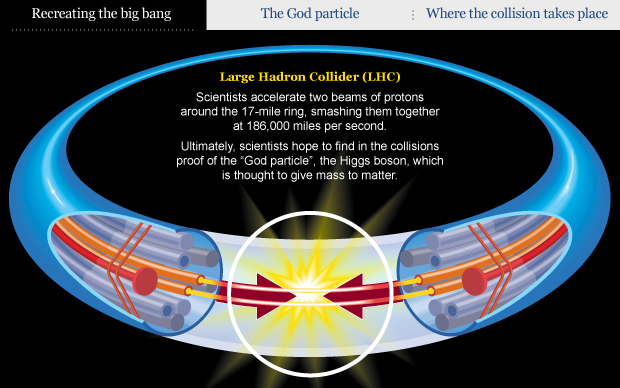What is the issue?
- CERN (the European Organization for Nuclear Research) recently found that Higgs boson decays to fundamental particles known as bottom quarks.
- Testing this and understanding more particles, require an upgradation to the Large Hadron Collider.
Why to study particles?
- Particle physics probes nature at extreme scales, to understand the fundamental constituents of matter.
- Particles communicate with each other in accordance with certain rules.
- These are embedded in what are known as the ‘four fundamental interactions’.
- The particles and three of these interactions are successfully described by a unified approach known as the Standard Model (SM).
- The SM is a framework that required the existence of a particle called the Higgs boson.
- The Large Hadron Collider (LHC) is the world’s largest and most powerful particle accelerator.
- One of the major aims of the Large Hadron Collider (LHC) was to search for the Higgs boson.

How are such tiny particles studied?
- Protons are collected in bunches.
- They are then accelerated to nearly the speed of light and made to collide.
- Many particles emerge from such a collision, termed as an event.
- The emergent particles exhibit an apparently random pattern.
- But they follow the underlying laws that govern part of their behaviour.
- Studying the patterns in the emission of these particles help understand the properties and structure of particles.
What is CERN's proposal?
- Higgs boson was discovered at the CERN Large Hadron Collider (LHC).
- The Higgs boson was detected by studying collisions of particles at different energies.
- But they last only for one zeptosecond which is 0.000000000000000000001 seconds.
- So, detecting and studying their properties requires an incredible amount of energy and advanced detectors.
- CERN has thus announced earlier this year that it is getting a massive upgrade to the LHC.
- This will be completed by 2026.
Why an upgrade?
- Luminosity is a measure of the number of protons crossing per unit area per unit time.
- Initially, the LHC provided collisions at unprecedented energies.
- This allowed scientists to focus on studying new territories.
- But, it is now time to increase the discovery potential of the LHC by recording a larger number of events.
- So upgrading (increasing the luminosity) will increase the rate of collisions.
- Eventually, the probability of most rare events will also increase.
- This offers scope for studying the properties of newly discovered particle and its effect on all other particles.
- In addition, understanding the properties of the Higgs boson will require their abundant supply.
- But the SM has its shortcomings, and there are alternative models that fill these gaps.
- It thus necessitates a High Luminosity LHC (HL-LHC).
How will it help?
- The beam in the LHC has about 2,800 bunches, each of which contains about 115 billion protons.
- The HL-LHC will have about 170 billion protons in each bunch, contributing to an increase in luminosity.
- After the upgrade, the total number of Higgs bosons produced in one year may be about 5 times the number produced currently.
- The experiments will be able to record about 25 times more data in the same period as for LHC running.
How will it be upgraded?
- The protons are kept together in the bunch using strong magnetic fields of special kinds.
- These are formed using quadrupole magnets.
- Focusing the bunch into a smaller size requires stronger fields.
- Therefore greater currents are employed, necessitating the use of superconducting cables.
- Newer technologies and new material (Niobium-tin) will be used to produce the required strong magnetic fields.
- The creation of long coils for such fields is being tested.
- New equipment will be installed over 1.2 km of the 27-km LHC ring.
- This will help in focusing and squeezing the bunches just before they cross.
- The LHC gets the protons from an accelerator chain.
- This will also need to be upgraded to meet the requirements of the high luminosity.
- Moreover, the length of each bunch is just a few cm.
- So, to increase the number of collisions a slight tilt is being produced in the bunches just before the collisions.
- This is to increase the effective area of overlap.
Source: Indian Express
